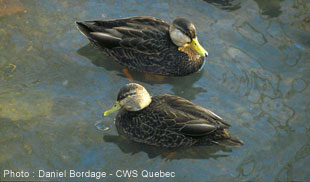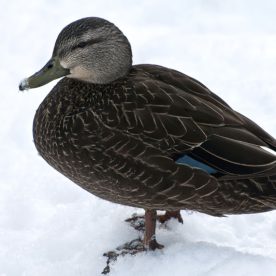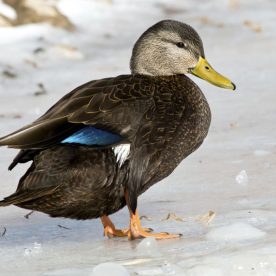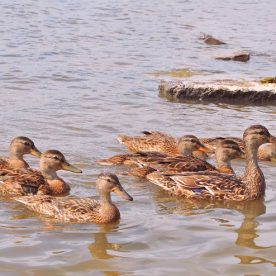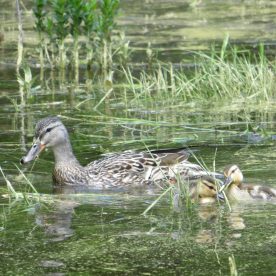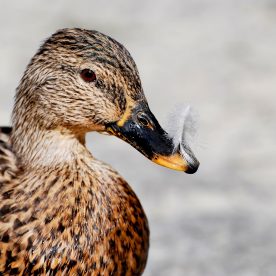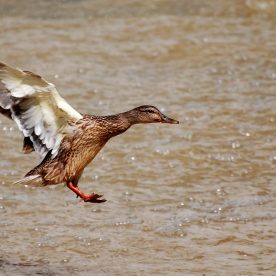Description
The American Black Duck Anas rubripes is a large dabbling duck that is commonly found throughout much of eastern North America. In contrast to its name, the American Black Duck is actually a dark dusky brown rather than black and is often referred to as “Dusky Duck”. They have relatively non descript dark dusky brown body plumage that transitions into a light brown, grey head characterized by a dark eye stripe. They have a brilliant purplish blue speculum, or wing patch, highlighted by black margins and stark white underwings that can be seen in flight. Male and female American Black Ducks share very similar plumage. They are considered to be the only common duck species in eastern North America in which the sexes are almost identical to each other. Upon closer inspection, Males can be distinguished from females by the color of their bills. Males have bright yellow-green bills while females have slightly drabber, olive colored bills. In addition to their similar appearance they have to each other, both male and Female American Black Ducks look similar to female mallards in size and color. As a result, they are often over looked as such, making them a common and yet uncommon sight in most ponds and marshes in North America. American Black Ducks can, however, be distinguished from the female Mallard by a few key differences in color. Mallards are an overall lighter brown than American Black Ducks and their speculum is highlighted by margins of white rather than black.
American Black Ducks are closely related to Mallards. Both species have the same habitat requirements and are often found together in areas where their populations overlap. About five percent of the wild ducks that look like American Black Ducks in eastern North America (in some local areas the percentage may be much higher) are actually hybrids, the result of cross-breeding between blacks and Mallards in the wild. Hybrids can be difficult to detect but watch for American Black Ducks with traces of green on the sides of their heads and traces of white bordering their blue speculums. Conversely, if you see birds that look like Mallards with some American Black Duck features, they are also hybrid offspring of American Black Duck–Mallard pairs.
Signs and sounds
The call of female American Black Ducks is a loud quack or series of quacks, indistinguishable from the call of female Mallards. The males have lower, softer, and shorter calls more like a low reedy quek.
Habitat and Habits
The American Black Duck occupies a variety of habitats across its breeding range. In Canada, the highest breeding densities of this duck occur in the Great Lakes–St. Lawrence River region of mixed forests. On the Atlantic coast and on the St. Lawrence estuary, the American Black Duck is particularly abundant in coastal marshes. In northern Ontario and Quebec, countless lakes, ponds, and streams provide an extensive but sparsely populated breeding area. Small groups also spend the nonbreeding season in southern Canada (see map), both inland, at ice-free sites where there is abundant food, and on the Atlantic coast, in bays and estuaries.
Like other dabbling ducks, the American Black Duck takes off from the surface of the water by rising straight up into the air, unlike the diving ducks, which run along the water to become airborne.
Unique characteristics
All ducks tend to return in fall and winter to the same marshes that they visited the previous year, but this trait is most pronounced in the American Black Duck. When tidal feeding areas have become frozen in New England, some American Black Ducks have starved rather than migrate farther south to unfamiliar ground.
Range
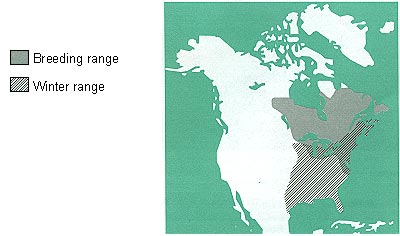
The American Black Duck is found in eastern and central North America, largely east of the Great Plains and south of the tundra.
As temperatures drop and the feeding areas freeze over one by one, the southward migration starts. The onset of migration is earliest (early September) in northern interior parts of the American Black Duck’s range and follows a broad front southwards and towards the coast. North American waterfowl migrate along one or more of four major flyways: the Atlantic, the Mississippi, the Central, and the Pacific. Most American Black Ducks follow the Atlantic Flyway, but about a third of them use the Mississippi. There is no mass movement of American Black Ducks, as occurs with some prairie ducks. The American Black Ducks move in groups of 20 to 100, leapfrogging each other from one area of good food to another.
When the northern birds reach southern Canada they encounter waterfowl hunters in significant numbers for the first time. American Black Ducks are naturally alert and wary, and they are among the most difficult of all ducks to deceive. To survive, they must learn to avoid decoys, calls, and blinds. They spend the daylight hours in “rafts” (flocks on the surface of the water) far out on large bodies of water where they cannot be approached. They come in to feed in fields of grain stubble or in freshwater marshes only at dusk and leave at the first streaks of dawn.
By the first week of November, migrating American Black Ducks have reached their northernmost nonbreeding areas along Lakes Erie and Ontario, the St. Lawrence River, and the Atlantic coast from the Bay of Fundy south. A few spend the nonbreeding season in the jagged bays of Nova Scotia. Grand Manan and the surrounding islands hold some, but most continue south.
Along the Atlantic coast, migrating American Black Ducks mingle with other birds, including Black, Surf, and White-winged Scoters, as well as Oldsquaws, Harlequin Ducks, eiders, Canada Geese, and Brant. This host moves south to the great bays and sounds of the nonbreeding grounds of the mid-Atlantic coast. As the migration progresses, the American Black Ducks from farthest north drop out, travelling just far enough south to assure an unfrozen food supply. Migration tapers off in early December.
In the interior of the continent, large numbers of American Black Ducks spend the nonbreeding season in the marshes and river valleys south of the Great Lakes.
Feeding
By the time ducklings have hatched, the surfaces of streams, lakes, marshes, and ponds are nutritious “soups” of mosquito larvae and other insects and tiny water animals which collectively are called aquatic invertebrates. This is the sole food of the ducklings for their first two weeks. They go on to larger items, such as tadpoles and snails, as they grow stronger, and finally begin dabbling for the seeds and tubers, or fleshy roots, of a variety of aquatic plants, as the adults do at this time of year.
Animal foods such as periwinkles, mussels, and various snails become increasingly important to American Black Ducks during their nonbreeding period on the coast. Birds inland continue to eat the seeds and other parts of various aquatic plants. Waste corn in harvested fields is an important food in late fall and winter, whenever it occurs near water areas used by the ducks.
Breeding
Adult black ducks begin selecting a mate in the fall, and probably most are paired by mid-December. Immatures begin pairing somewhat later, but almost all American Black Ducks arrive paired at the breeding grounds in the spring.
The female selects the nest site, usually in a clump of grass, under a shrub or tree, or in a hole or fork in a tree, near the ground. She digs a scrape (nest) using both feet and her bill, then lines it with grasses, leaves, and other dry plant material. She plucks down, or fine feathers, from her body and adds it to the nest during the approximately one- to two-week period when she is laying her seven to 12 (nine on average) creamy white, or sometimes greenish-buff, eggs.
Incubation, or protection of the eggs until they hatch, takes up to 29 days from the laying of the last egg. Whenever the female leaves the nest during this time, she covers the eggs with down to keep them warm; the male remains nearby for another one to three weeks but does not sit on the eggs. As incubation progresses the males become more and more restless and leave the sitting females for increasing stretches.
Around the time that the first eggs hatch, the males fly to the nearest large body of water and congregate in the centre. Here they moult, or shed their old feathers. They remain flightless for about 10 days until their new primary feathers grow in. Their protection from enemies, such as people, hawks, and owls, at this vulnerable time depends on the fact that it is impossible to approach them unseen on their open lake. They dive to escape danger.
The chicks hatch within a few hours of one another. Shortly afterwards, the female leads them to water to feed. If the nest is far from water and the spring run-off has dried up, this journey may be long and difficult for the young ducklings.
The female guards the ducklings closely for seven to eight weeks until their first flight feathers appear. Then, leaving the young to feed and learn to fly, the female retires into a secluded area to moult. She loses her flight feathers, also remaining flightless for about 10 days until a complete set of new feathers grows in.
As soon as the young are capable of flying from the marshes to the open lakes they leave the females and join the males. Later the females arrive one by one, flying out of the marshes on their newly feathered, shining wings.
Conservation
While hardy, this duck has nevertheless been a focus of concern among conservationists in recent decades. Once the most abundant dabbling duck in eastern North America, the American Black Duck began a serious population decline in the 1950s, and its populations reached all-time lows in the early 1980s. Populations are currently steady, but there are only about half as many American Black Ducks as there were in the early 1950s.
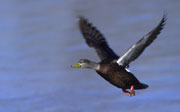
Photo: USFWS/Maslowski Photo
The decline in the American Black Duck population between the 1950s and the 1980s occurred for a variety of reasons, including habitat losses in both breeding and wintering areas, hunting, competition with Mallards for nesting sites, as well as hybridization with Mallards. In Canada during that 30-year period, habitat loss in the agricultural and industrialized areas of southern Ontario and Quebec led to serious declines in American Black Duck breeding populations. Subsequent surveys indicated that the Canadian population was stabilizing. In the remaining forested breeding habitat, including most of northeastern Ontario, boreal Quebec, and the Atlantic provinces, American Black Duck breeding populations were stable or increasing.
As an initial response to the continental decline of American Black Ducks, the United States and Canada tightened hunting restrictions in 1983 and 1984 respectively. In Canada, further tightening of restrictions was needed, and the improved regulations were introduced in 1989 and 1990. The average number of American Black Ducks killed by hunters yearly has fallen by about 26 percent in Canada since 1989. The corresponding drop in the United States was about 44 percent.
The signing of the joint Canada–United States North American Waterfowl Management Plan (NAWMP) in 1986 was another important step forward in the conservation of the American Black Duck. NAWMP is a plan to protect and enhance wetland habitat throughout North America. It aims to restore the populations of ducks, geese, and swans to the levels of the 1970s.
Large-scale aerial surveys of breeding populations of all species of eastern ducks, Canada Geese, and some non-game species initiated in 1990 by the Black Duck Joint Venture, a working group under NAWMP, are providing important data for an ongoing analysis of breeding population trends.
In wintering areas, wildlife managers face problems posed by the degradation and destruction of American Black Duck habitat. For example, mid-Atlantic coastal areas have been affected by ditch-building to control mosquito populations, coastal lagoon and housing developments, and environmental contamination by pollutants.
There is no solid evidence of major decreases in quality or quantity of breeding habitat for American Black Ducks since the late 1980s, except in specific areas, such as those disrupted by the James Bay hydroelectric project. An increase in beaver populations may even be creating more wetland breeding habitat.
In shared habitat, competition and cross-breeding with the genetically dominant Mallard could be contributing to the decline of the American Black Duck as a distinct species. Since 1940, about 1.7 million game-farm Mallards have been released within the range of the American Black Duck. Not only does this increase the problem of hybridization, or crossbreeding, it also increases competition for breeding sites, because both species appear to prefer wetlands with similar characteristics.
Toxic chemicals also affect the American Black Duck breeding population. The traces of DDT that remain in the food chain today are believed to have minimal effects. (The U.S. banned DDT in 1971, and Canada has phased out its use.) However, the less persistent toxic chemicals now being used for spruce budworm control can cause temporary reductions in the aquatic invertebrate foods, such as insects and tiny water animals, available to ducklings. When acid rain or snow causes water to become acidic, many invertebrates die, causing ducklings to starve.
Lead poisoning from lead shot and fishing tackle has caused death and other effects in waterfowl for over 30 years. Lead poisoning may weaken birds, so they are more susceptible to disease. In Canada, lead-free hunting zones have been set up in areas where the problem is serious, and in the United States there was a ban on lead shot in 1991. Ducks’ exposure to lead is expected to decline.
Resources
Online resources
Print resources
Bellrose, F.C. 1980. Ducks, geese and swans of North America. Stackpole Books, Harrisburg, Pennsylvania.
Bent, A.C. 1923. Life histories of North American wildlife order Anseres. U.S. National Museum Bulletin 126.
Godfrey, W.E. 1986. The birds of Canada. Revised editon. National Museums of Canada, Ottawa.
Rusch, D.H., C.D. Ankney, H. Boyd, J.R. Longcore, F. Montalbano III, J.K. Ringelman, and V.D. Stotts. 1989. Population ecology and harvest of the American Black Duck: a review. Wildlife Society Bulletin 17(4):379–406
Wright, B.S. 1966. Black duck spring. Clarke Irwin Co., Toronto.
© Her Majesty the Queen in Right of Canada, represented by the Minister of the Environment, 1973, 1980. All rights reserved.
Catalogue number CW-4/17
ISBN 0-662-10775-6
Text: Bruce S. Wright
Revision: Mary Wyndham
Photo: Canadian Wildlife Service



